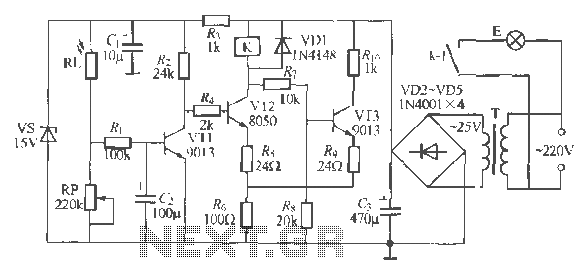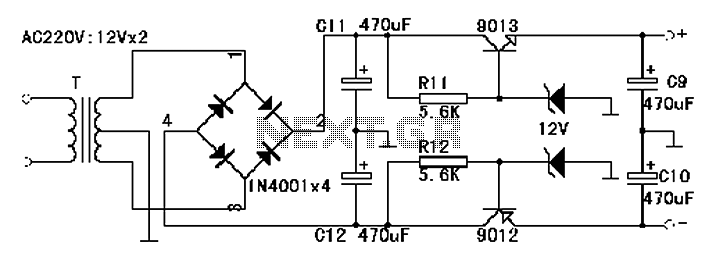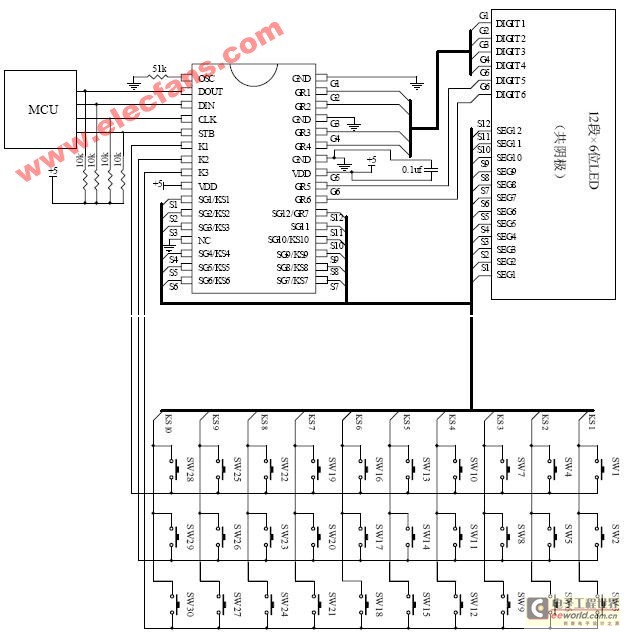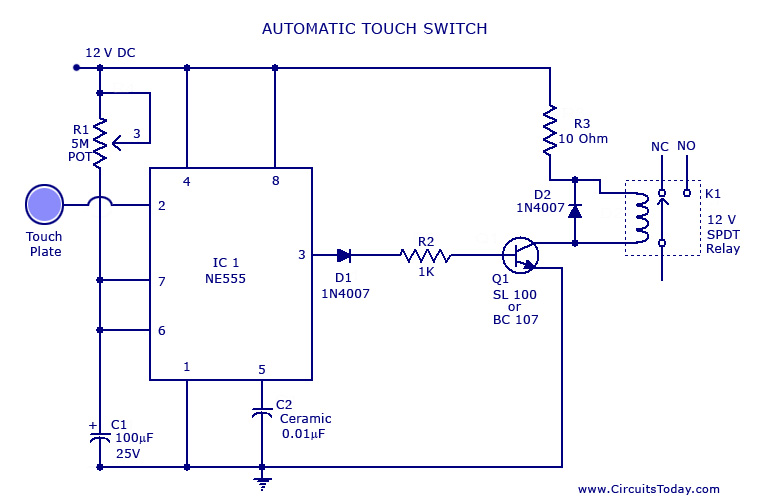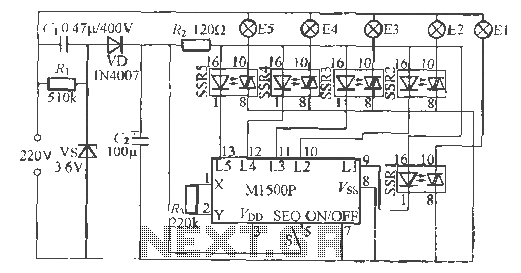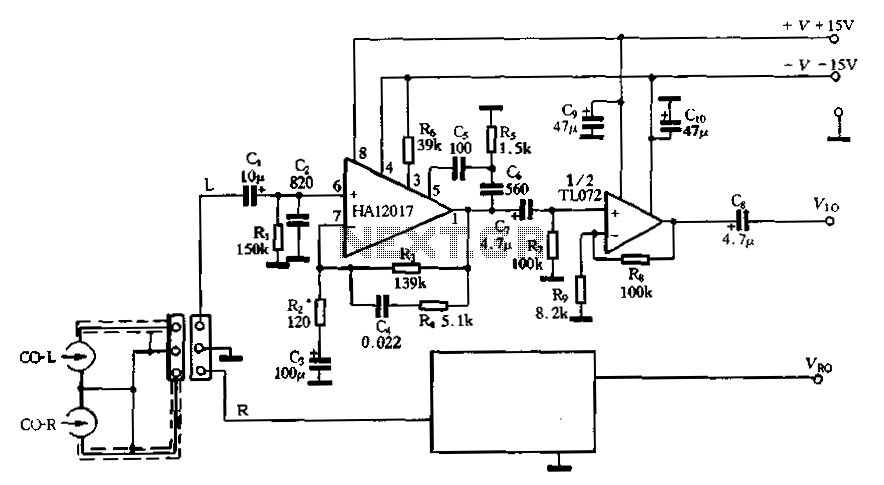
Christmas lights consisting of a circuit diagram of optocoupler
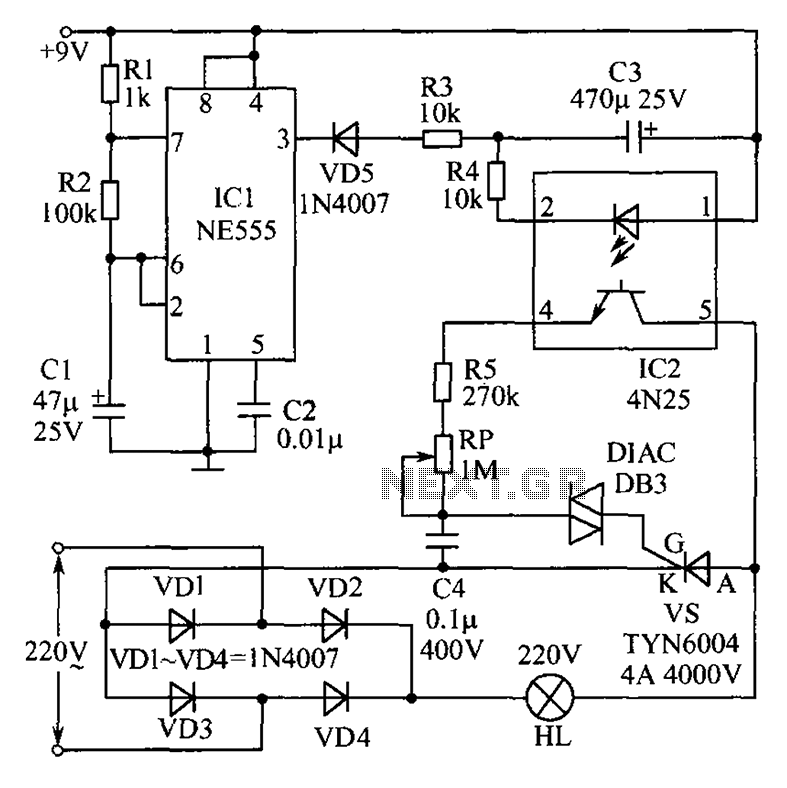
This circuit features an appealing Christmas lights setup. Upon activation, the lights (HL) gradually increase in brightness. Once they reach maximum brightness, they automatically dim, and upon reaching the lowest brightness, they gradually brighten again, creating a smooth transition throughout the entire process. The change in brightness is influenced by the discharge of capacitor C3. When the output of IC1 (NE555) pin 3 is high, capacitor C3 discharges through IC2 (CN25) optical isolation, causing the brightness of lantern HL to begin to decrease. IC1 is configured as a non-stable oscillator, with its frequency determined by resistors R1, R2, and capacitor C1.
The described Christmas lights circuit utilizes an NE555 timer integrated circuit (IC1) configured in a non-stable mode to create a continuous oscillation that controls the brightness of the lights (HL). The circuit's operation begins when power is applied, allowing the timer to generate a square wave output. The frequency of this oscillation is determined by the values of resistors R1 and R2, along with capacitor C1, which set the timing intervals for the charging and discharging cycles.
As the output from pin 3 of the NE555 goes high, capacitor C3, which is connected to the circuit, begins to discharge through the optical isolator IC2 (CN25). This discharge process causes the brightness of the lights (HL) to decrease gradually. The optical isolator serves as a safety mechanism, ensuring that the high voltage present in the lighting circuit does not affect the low voltage control circuit.
Once the lights reach their minimum brightness, the NE555 timer output transitions low, allowing capacitor C3 to recharge. This recharging phase enables the lights to gradually brighten again, completing the cycle. The smooth transitions between bright and dim states create an aesthetically pleasing effect, ideal for festive decorations. The entire circuit is designed to provide a visually appealing illumination effect while ensuring reliable operation through the use of standard electronic components.
In summary, this Christmas lights circuit is an excellent example of utilizing basic electronic components to achieve a dynamic lighting effect, making it suitable for various decorative applications during the holiday season. As shown is a very attractive Christmas lights circuit. When the power is turned on, lights HL will gradually become brighter; when it reaches the brightest, it will automatica lly gradually darken; et brightness of the darkest time, will automatically brighten gradually, so repeated. Smooth the entire change process. Brightness change process depends on the charger lights HL capacitor C3 discharges. When IC1 (NE555) 3-pin output is high, the capacitor C3 begins to discharge through the IC2 (CN25) optical isolation, lantern HL brightness began to decline.
IC1 here set no stable oscillator whose frequency is determined by R1, R2 and C1.
The described Christmas lights circuit utilizes an NE555 timer integrated circuit (IC1) configured in a non-stable mode to create a continuous oscillation that controls the brightness of the lights (HL). The circuit's operation begins when power is applied, allowing the timer to generate a square wave output. The frequency of this oscillation is determined by the values of resistors R1 and R2, along with capacitor C1, which set the timing intervals for the charging and discharging cycles.
As the output from pin 3 of the NE555 goes high, capacitor C3, which is connected to the circuit, begins to discharge through the optical isolator IC2 (CN25). This discharge process causes the brightness of the lights (HL) to decrease gradually. The optical isolator serves as a safety mechanism, ensuring that the high voltage present in the lighting circuit does not affect the low voltage control circuit.
Once the lights reach their minimum brightness, the NE555 timer output transitions low, allowing capacitor C3 to recharge. This recharging phase enables the lights to gradually brighten again, completing the cycle. The smooth transitions between bright and dim states create an aesthetically pleasing effect, ideal for festive decorations. The entire circuit is designed to provide a visually appealing illumination effect while ensuring reliable operation through the use of standard electronic components.
In summary, this Christmas lights circuit is an excellent example of utilizing basic electronic components to achieve a dynamic lighting effect, making it suitable for various decorative applications during the holiday season. As shown is a very attractive Christmas lights circuit. When the power is turned on, lights HL will gradually become brighter; when it reaches the brightest, it will automatica lly gradually darken; et brightness of the darkest time, will automatically brighten gradually, so repeated. Smooth the entire change process. Brightness change process depends on the charger lights HL capacitor C3 discharges. When IC1 (NE555) 3-pin output is high, the capacitor C3 begins to discharge through the IC2 (CN25) optical isolation, lantern HL brightness began to decline.
IC1 here set no stable oscillator whose frequency is determined by R1, R2 and C1.
